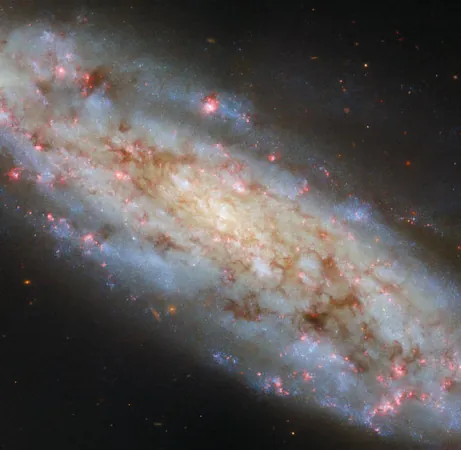
Hubble Unveils Breathtaking New Image of NGC 3511
2025-05-19
Author: Mei
Discover the Beauty of NGC 3511!
The Hubble Space Telescope has unveiled an astonishing new image of the intermediate spiral galaxy NGC 3511, effortlessly captivating observers with its stunning details.
A Cosmic Wonder 43 Million Light-Years Away
Located approximately 43 million light-years from Earth in the constellation of Crater, NGC 3511—also known as ESO 502-13 or IRAS 11009-2248—boasts an impressive diameter of 107,000 light-years.
A Historical Discovery
Discovered by the renowned astronomer William Herschel on December 21, 1786, NGC 3511 is part of a small galaxy group that includes NGC 3513 and ESO 502-024, showcasing the intricate dance of cosmic neighbors.
Hubble's Unique Perspective
From its orbit high above Earth, the Hubble telescope captures NGC 3511 at an angle of about 70 degrees—an ideal view that blends the beauty of spiral arms with the mysterious allure of galaxies that appear edge-on.
A Kaleidoscope of Colors
This captivating color image is crafted from a series of exposures across the ultraviolet, visible, and near-infrared wavelengths, taken with Hubble’s advanced Wide Field Camera 3. Six specialized filters were employed to capture various light wavelengths, resulting in a breathtaking spectrum of colors.
Studying the Star Formation Cycle
Astronomers are using NGC 3511 to explore star formation cycles in nearby galaxies. Hubble’s observations are part of a broader survey aimed at recording the appearances of 55 local galaxies with five incredible filters allowing for distinct wavelengths of light.
A Glimpse into the Cosmic Nursery
Among the stunning features visible in this image are giant clouds of hydrogen gas, which glow brilliantly red when energized by ultraviolet light from hot, young stars. These vibrant gas clouds curl around clusters of brilliant blue stars, painting a picture of cosmic creation.
Unlocking the Secrets of Star Ages
Hubble’s study will not only capture the beauty of these stars but will also help astronomers catalogue and measure their ages. Many of these stars are relatively young, typically just a few million years old and several times more massive than our own Sun.

 Brasil (PT)
Brasil (PT)
 Canada (EN)
Canada (EN)
 Chile (ES)
Chile (ES)
 Česko (CS)
Česko (CS)
 대한민국 (KO)
대한민국 (KO)
 España (ES)
España (ES)
 France (FR)
France (FR)
 Hong Kong (EN)
Hong Kong (EN)
 Italia (IT)
Italia (IT)
 日本 (JA)
日本 (JA)
 Magyarország (HU)
Magyarország (HU)
 Norge (NO)
Norge (NO)
 Polska (PL)
Polska (PL)
 Schweiz (DE)
Schweiz (DE)
 Singapore (EN)
Singapore (EN)
 Sverige (SV)
Sverige (SV)
 Suomi (FI)
Suomi (FI)
 Türkiye (TR)
Türkiye (TR)
 الإمارات العربية المتحدة (AR)
الإمارات العربية المتحدة (AR)